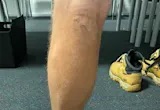- Chris Comans
- 2 Comments
When people think of skin cancer, they often picture the face, shoulders, or arms—areas that get the most sun. But one of the most overlooked and high-risk zones is the legs. In fact, legs are one of the most common places for skin cancers to develop, particularly Squamous Cell Carcinomas (SCCs), and they’re also the leading site for melanomas in women.
Here in Western Australia, where outdoor lifestyles, high UV levels, and hot summers dominate our way of life, the legs are frequently exposed. Whether it’s wearing shorts, skirts, or bathers at the beach, our legs can accumulate decades of sun damage.
Why the Legs Are So Vulnerable
The skin on the legs is often unprotected. Many people apply sunscreen to their face, neck, and arms but neglect the lower body. Even those who use sun protection regularly often forget to reapply after swimming, sweating, or walking outside for long periods.
Occupational exposure also plays a part. I regularly screen men who work outdoors in high-vis shorts and boots. Their calves are deeply tanned, but their ankles and feet remain pale—classic signs of long-term, uneven sun exposure. This constant exposure pattern creates an environment where SCCs thrive.
For women, lifestyle and clothing choices mean the legs, particularly the lower legs, are often uncovered. This is one of the reasons why melanoma is most commonly diagnosed on the legs in women.
A Real Example: SCC and Sun Damage on the Legs
The image provided shows a classic case of uneven sun exposure, where the calf is deeply tanned but the skin below the ankle is significantly lighter. This stark contrast highlights the intensity of UV radiation that the lower legs endure in WA’s climate.
Over time, this kind of exposure can cause actinic keratoses (precancerous scaly spots) to appear, which may progress into Squamous Cell Carcinomas (SCCs). SCCs on the legs often present as rough, crusty patches, sores that don’t heal, or tender raised lumps.
It’s not unusual for people to dismiss these as scratches, insect bites, or “just a sore that takes a while to heal.” But ongoing sun exposure, particularly on the legs, means that any persistent spot needs proper attention.
Common Skin Cancers Seen on the Legs
1. Squamous Cell Carcinoma (SCC):
Very common on the legs due to cumulative sun exposure. Appears as scaly, red patches or painful, raised growths. Can spread if not treated early.
2. Basal Cell Carcinoma (BCC):
Less common on the legs compared to the head and neck. Appears as shiny pink or pearly nodules. Slow-growing but can still cause local damage.
3. Melanoma:
The deadliest skin cancer, and the legs are the most common site for women. Can present as a new dark mole, or a change in colour, size, or shape of an existing mole.
Western Australia’s Outdoor Culture
WA’s beaches, sporting lifestyle, and climate make us one of the most sun-exposed populations in the world. For men, fishing trips, sports, and outdoor work keep their calves exposed daily. For women, beach days and summer clothing contribute to cumulative damage over time.
This is why skin cancers on the legs are a frequent finding in my screenings. Many clients are surprised when I detect suspicious lesions on their lower limbs—they often hadn’t thought to check or protect those areas consistently.
Protecting Your Legs from Sun Damage
1. Apply Sunscreen Daily:
Don’t stop at your arms and face—cover your legs as well. Remember to reapply after swimming or sweating.
2. Cover Up When Possible:
Longer shorts, skirts, or lightweight pants can reduce sun damage. Even breathable fabrics provide significant UV protection.
3. Be Wary of Reflected UV:
Sand, water, and concrete bounce UV rays back onto the legs. This can mean you’re getting double the exposure at the beach or pool.
4. Check Your Legs Regularly:
Look for sores that don’t heal, scaly patches, or new moles. Don’t ignore anything that lingers longer than a few weeks.
Why Early Detection Saves Lives
SCCs on the legs can become invasive if ignored, while melanomas can spread quickly and become life-threatening. The earlier these cancers are found, the easier they are to treat.
As a Skin Cancer Screening Practitioner at Skin Chx, I pay special attention to the legs during checks because I know how often they are overlooked by clients in their own self-checks. My role is to detect those subtle warning signs before they become a serious problem.
Final Thoughts
In Western Australia, the legs are a high-risk site for skin cancer. Whether it’s SCCs from years of sun exposure or melanomas that are more common in women, the lower limbs are one of the first areas I recommend people take seriously when protecting their skin.
Applying sunscreen to your legs, covering up where possible, and committing to regular skin checks are some of the simplest but most powerful ways to reduce your risk.
Skin cancer doesn’t discriminate—but with awareness and prevention, you can protect yourself and catch issues early when they are far more manageable.


Viruses, Immunity & Skin: When Body's Defences Falter | Skin CHX
Viruses, Immunity & Skin: When Body's Defences Falter